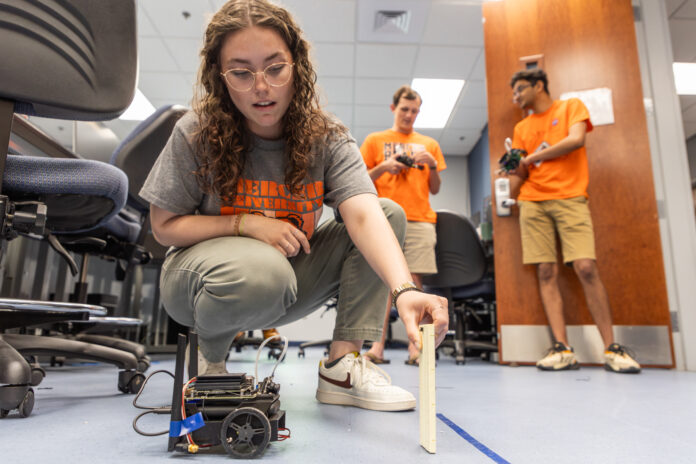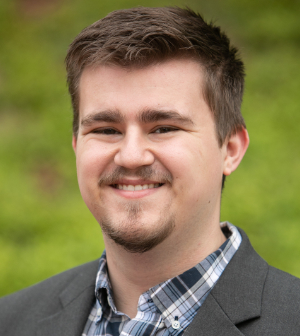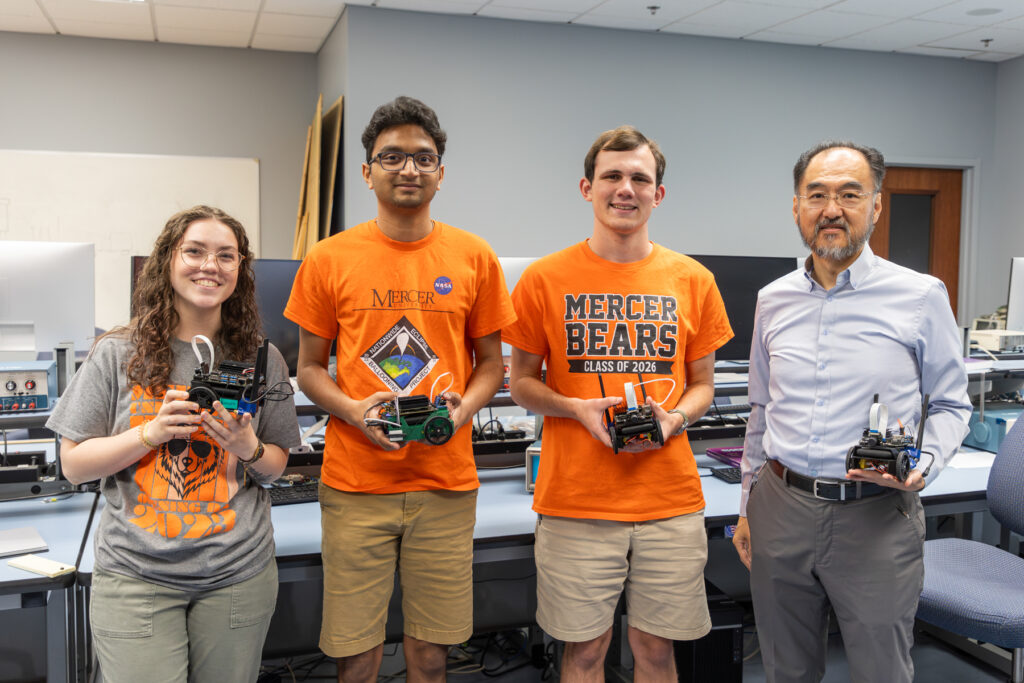
As artificial intelligence becomes more common in everyday life, a Mercer University School of Engineering professor is working to ensure the next generation is knowledgeable about the field.
Dr. Anthony Choi, professor of electrical and computer engineering, hopes his new curriculum will inspire middle and high school students to seek careers in artificial intelligence, as well as prepare them to make educated decisions about how AI technology is used in society.
Now is the time to start exposing these students to artificial intelligence, so they will consider studying it in college and pursuing it as a career, Dr. Choi said.
When computer programming rose to prominence, the U.S. suffered from a shortage of programmers because students were unprepared, he said. He doesn’t want that to happen with AI.
“If we wait until we need all those AI engineers and then say, ‘Oh, you know what? We don’t have enough. Now let’s invest the money,’ we’re going to go through the exact same problems that we went through (with computer programmers),” he said. “My idea is, let’s beat everybody to the punch. Once you just expose students to the possibility, you’d be surprised how many will actually open up their minds and consider it an option.”
Beyond building a workforce, being knowledgeable about artificial intelligence will soon be an important part of everyone’s civic duty, Dr. Choi said.
“In the very short future, we are going to start having to vote on regulations and policies based upon how to deal with AI in our daily lives, in our education, in our economy, in our military, whatever it may be,” he said. “So, if we don’t have enough people that just have a basic understanding of AI, how are they going to be knowledgeable enough to be able to vote properly and make competent decisions on a technology that they have no idea about?”
Powered by a $1 million NASA grant
Dr. Choi is two years into a three-year $1 million grant that supports designing and developing a curriculum to teach artificial intelligence to middle and high school students. The grant was awarded through NASA’s Space Grant K-12 Inclusiveness and Diversity in STEM program, known as SG KIDS.
Dr. Choi’s project, titled “Inspiring NASA’s Next Generation Through Building, Coding and Machine Learning Missions,” or NASA ML-Bots for short, will teach the fundamentals of coding, artificial intelligence and machine learning to middle and high school students in Georgia, Alabama, Louisiana and Tennessee.
The NASA ML-Bots curriculum consists of five modules.
The first module introduces students to artificial intelligence and machine learning, a branch of AI that gives computers the ability to learn. The module also helps students access the computing power and code they need to learn.
“You need access to very powerful computers to be able to do machine learning and artificial intelligence. Most people do not have access to such powerful computers,” Dr. Choi said. “What we do is bring in a few components that allow any high school to actually get their hands on computing power that is powerful enough to do AI.”
The second module covers neural networks, the computing architecture that drives modern day artificial intelligence. AI tools like ChatGPT, facial recognition software and language translation apps use neural networks, Dr. Choi said.
In this module, students will develop code for a neural network and train a small, car-like robot to avoid obstacles using machine learning.

In the past, a programmer needed to write detailed code telling the robot how to avoid every possible obstacle. In this exercise, students use a camera mounted on the robot to teach it how to avoid objects in its path.
“You take a lot of pictures and separate them into ‘obstacle’ or ‘no obstacle,’ and then you give (the robot) back the data and tell it to learn. Basically, it looks at those pictures and learns how to know when there is an obstacle in front of it and when there is no obstacle in front of it,” Dr. Choi said. “And once it learns that, you write a little code that says if there is an obstacle in front of you, turn left. If there’s no obstacle, go forward. Once you write that simple code, you put (the robot) down, and it will actually navigate around the room, even though it sees things it has never seen before.
“That’s a paradigm shift in terms of how we used to actually program robotics, and our students are going to be able to do that with their hands and physically get that working.”
The third module will cover genetic algorithms, which are used to generate high-quality solutions. The fourth module will discuss natural language processing, which allows computers to understand and generate human language. Chatbots and ChatGPT use natural language processing, Dr. Choi said.
The fifth and final module will be a competition phase themed around NASA’s Artemis campaign to explore the moon. This is still being developed.
Each module is designed to be taught in four to six hours. Some schools may choose to have a weeklong program, while others may stretch it out over a semester.
Mercer students contribute to AI curriculum
University students played integral roles in the development and testing of the NASA ML-Bots curriculum, which includes written and video instruction.

Alumnus Caden Hamrick, who graduated with a degree in computer engineering in 2023, got involved at the project’s inception and continued to work on it after graduation. He’ll start his Ph.D. in electrical engineering at the University of Utah in the fall as a recipient of the National Science Foundation Graduate Research Fellowship.
“It’s been pretty transformative,” he said of working on the project. “In addition to getting research experience, as a person who wants to go into academia and science, getting that experience doing science communication and education-type work has really helped refine my ability to communicate information effectively.”
As part of the process, Hamrick taught high school students the curriculum to gauge its effectiveness. He enjoyed seeing them interact with the material. These sessions also provided insight as to where the content was too high-level or could be better explained.
“The most challenging thing has been developing material for a high school audience,” he said. “Trying to figure out what is actually going to be useful to high school students, how we actually meet students where they’re at instead of just teaching them information, that process has been difficult.”
Ultimately, Hamrick said he feels like the team has been able to write the curriculum in such a way that students will be able to understand, regardless of their prior knowledge or experience.

Rising junior Louisa Houser, a computer science major, has spent the past year working on the NASA ML-Bots project.
Developing the modules took a great deal of research, and Houser said she learned a lot about AI through the process. She also gained experience building robots and teaching students, she said.
The content is interesting, and though some students may find it intimidating, she thinks the videos and robots will be a great way to engage them.
The Georgia Space Consortium, Alabama Space Grant Consortium; LaSTEM, an affiliate of the Louisiana Space Grant Consortium; and the University of Tennessee Chattanooga, an affiliate of the Tennessee Space Grant Consortium, will deliver the curriculum throughout their states.
Dr. Choi recently used the NASA ML-Bots curriculum as a basis for training some Dooly County teachers in artificial intelligence. Dr. Juone Brown, a computer science and business technology teacher at Dooly County High School, said learning the material was fun and easy.
“I really feel a lot more confident being able to go into the classroom and talk intelligently about the concepts,” she said. “Dr. Choi is able to take concepts that are very difficult and makes them very easy to understand.”








